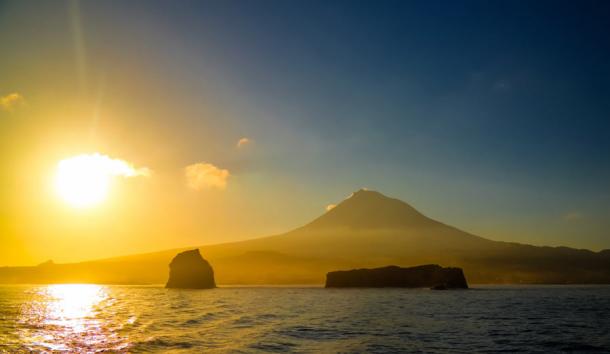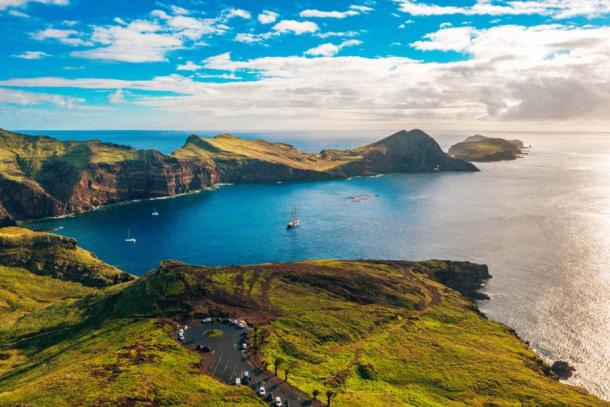Until now it was believed that the Azores island group was discovered by Portuguese sailors in the 15th century. However, a new study shows Norse explorers had brought animals to the islands 700 years earlier. Furthermore, the Norsemen burned and engineered the wild wooded landscape to better suit cattle grazing.

The view of Mt. Pico which early explorers would have seen before reaching the Azores. ( homocosmicos / Adobe Stock)
Located 900 miles (1,448 km) off the coast of Portugal and 930 miles (1,497 km) northwest of Morocco, the Azores are a string of nine volcanic islands in the mid North Atlantic Ocean. The islands first become visible to mariners when the 7713 foot (2,351 m) Mt. Pico came into view, and this famous peak is often associated with the mount at the center of the legendary Atlantis, the mythical Ice Age kingdom written about by Plato. Now, the foundation story of these remote islands has been tipped upside down.
According to the current mainstream narrative, Prince Henry the Navigator, based at Tomar in Portugal, is believed to have commissioned Portuguese sailor Diogo de Silves to land on Santa Maria Island in 1427 AD during his search for new oceanic trade routes to Asia. According to Azores GeoPark website history records, Infante D. Henrique first introducing large animals to the island between 1431 and 1432, later sending the first human settlers in 1439. But this traditional history of the Azores has just been rewritten.

The Monument of the Discoveries in Lisbon celebrates the Portuguese Age of Discovery, during which it was believed Diogo de Silves discovered the Azores. ( visualcortex / Adobe Stock)
Finding Answers in Ancient Fecal Matter in the Azores
An international team of researchers has published a new study in the scientific journal Proceedings of the National Academy of Sciences . The study explains that stigmastanol is found in many plant types, but it also inhibits biosynthesis of cholesterol in the livers of animals. According to an article on PHYS, co-author Timothy Shanahang of the University of Texas said the team analyzed stigmastanol samples from fecal matter that had been left on the island by imported animals, and they all dated to between 700 and 850 AD, 700 years before the supposed Portuguese discovery.
This early occupation date was supported by the results of an analysis of sediment cores taken from Pico Island’s Lake Peixinho. These samples showed an “increase in charcoal particles” in the 8th century suggesting the first explorers burned huge fires. According to Northern Bush , “slash and burn” was a Norse method of cutting and burning forests and woodlands to create fields and pasture, traditionally known as swiddens. Both the stigmastanol and charcoal samples pointed towards a new settlement date for the Azores of around the mid-8th century.

Aerial image of the Azores in the mid North Atlantic Ocean. ( ingusk / Adobe Stock)
Rewriting European Navigational History of the Azores
In a statement published in EurekAlert!, Santiago Giralt, co-author of the new study and a paleoclimatologist at Geosciences Barcelona, said that between 700 and 850 AD a “drop was noted in native tree pollen.” This observation cemented the emerging hypothesis that people were burning down native forests to create pasture land for grazing cattle some 700 years before the first Portuguese explorers arrived in in 1427 AD.
Lead author Pedro Raposeiro, of the University of the Azores, said in the release that the new study also shows that sediments gathered from a lake on another Azores island showed evidence of “non-native ryegrass.” Finding evidence that Norse explorers had arrived in the Azores in the 8th century with large animals and grasses native to Scandinavia, 700 years before the Portuguese, is a major discovery. However, perhaps the most interesting observation to arise from the new study is that these early human settlers on the islands sparked “a profound environmental and ecological disturbance,” wrote Raposeiro in the study.
Furthermore, it was rapidly changing ecological conditions that were identified as the primary reason the Norse explorers arrived in the 8th century. A series of climate simulations, based on data gathered from the new sediment cores, suggested the seamen took advantage of “abnormally robust northerly winds and weaker westerly winds to sail from northern Europe” which occurred in the 8th century.
Top image: New evidence proves that Norse explorers discovered the Azores 700 years before the Portuguese. Source: Catmando / Adobe Stock
By Ashley Cowie
 RSS Feed
RSS Feed















 October 11th, 2021
October 11th, 2021  Awake Goy
Awake Goy  Posted in
Posted in  Tags:
Tags: 













